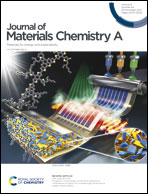Synthesis design of a 3D interfacial structure for highly reversible lithium deposition†
Abstract
Metallic lithium (Li) is a highly promising anode for high-energy-density batteries. However, irreversible Li deposition and Li dendrite growth during cycling, originating from an unstable interface and chemical disintegration, are the most serious challenges for the commercialization of Li metal anodes. Herein, we propose a sustainable synthesis route to achieve a highly reversible and stable Li anode by constructing a three-dimensional (3D) graphene network host decorated with highly dispersed lithiophilic inorganic components (Li2O and Li2CO3) and coated with an insulating interphase of boron nitride, termed BIG. Homogeneous Li plating and bottom-up deposition can be achieved due to the Lewis acid and insulating nature of boron nitride in the BIG architecture. The uniformly decorated inorganic components on the 3D graphene network benefit the construction of a robust inorganic-rich solid electrolyte interface, enabling highly reversible Li deposition. Therefore, the free-standing BIG electrode delivers a superior cyclability of 150 cycles at an areal capacity of 3.0 mA h cm−2 with low voltage hysteresis for Li plating/stripping. When coupled with a LiFePO4 cathode, the as-assembled full cell can stably operate for over 350 cycles with negligible capacity degradation and a low overpotential of 47 mV. This work provides a convenient and cost-effective method to develop highly stable Li metal anodes by comprehensively regulating the interfacial structure and chemistry.



 Please wait while we load your content...
Please wait while we load your content...